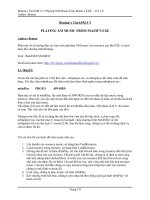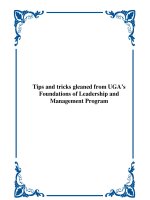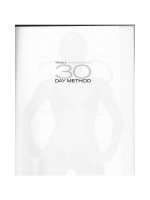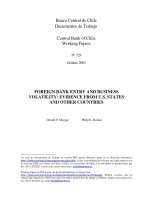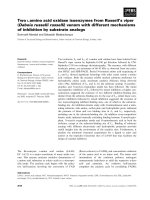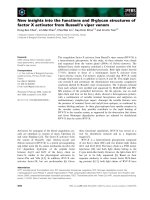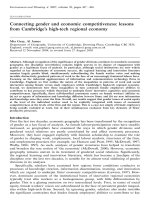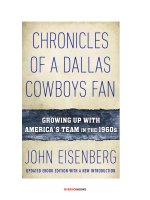Fashion History From 1960''''s - Present Day
Bạn đang xem bản rút gọn của tài liệu. Xem và tải ngay bản đầy đủ của tài liệu tại đây (1.56 MB, 45 trang )
Fashion
History
1960’s – Present Day
1960’s A-Line
The 60’s opened with the
simple A-line dress. Most
dresses were very simple
and so accessories were
both expressive and bold.
Some fashion history
writers have called this era
the “Great masquerade.”
Eyes were lined with black,
shadowed with frosty white,
and topped off with a full set of
false eyelashes. Lips were
painted light to white.
Twiggy was the top model.
She was long and lean, which
was a break from the fleshed
Edwardian beauty seen in
some form up through the
1950’s
1 9 6 0 ’s
1960
Everything seemed to go. The length
might be mini, micro-mini, midi, or maxi.
Even mixing these lengths was
fashionable; a mini skirt with a maxi coat
or vest. Maxi coats and sweater coats
were really practical in cold climates for
the mini skirt wearer.
The “warbabies” or Baby Boomers,
infants born immediately after the war
ended in 1945, were maturing. By 1960
teenagers were a powerful group. In
France, by the 1960’s one-third of the
population was under the age of 20. In
the United States, fully one-half of the
population was under 25. This
enormous group of energetic young also
had their own minds for fashion and
were not dictated to by Paris or by
anyone else.
1960’s – A-Line
The 1960’s was a time of action, violence,
protest, rebellion, experimentation, and
counterculture. Dramatic events took place
during this decade and dramatic changes in
fashion occurred.
The 60-70’s catered to the youth both in
advertising and production in the clothing
industry. Teenagers had money to spend
(3.5 billion on apparel in 1965,) and enjoyed
keeping up with the latest trends. During
these years two sets of fashion developed
side by side: fashion for the young and
fashion for the rest of society.
1960
No other landmark of the 60’s was the pants suit.
“Women had attempted pants since the days of Mrs.
Bloomer. Chanel, in the 1930’s made them acceptable
as sportswear and during the war years overall and
jeans were a practical necessity. But trousers for
women always had decided overtones of the resort or
the assembly line. They had never been totally
respectable.
A major fashion breakthrough of the late 60’s was the
tailored pants suit. It was seen everywhere and was
chic, elegant, comfortable, and convenient, not to
mention practical.
Movements of the
60’s Civil Rights
There were three major movements during the 60’s that
helped to shape fashion:
First – The Civil Rights Movement sparked an
impressive move to ethnic fashion. Blacks and whites
alike found interest in the African colors and prints. Afro
hairstyles were worn by most blacks and some whites
used perms to get the Afro hairstyle. Some Afros could
be measured at 3 inches above the scalp going straight
up and straight out. Most were shorter and more
natural looking. The expression of the day was “Black
is Beautiful.”
Women’s Liberation
Second – The Women’s Liberation Movement caused
women to burn their bras and wear men’s clothing. The
“unisex” clothing, clothing worn by both sexes, is a
result of this movement coupled with the sexual
revolution that was taking place at the same time. Girls
turned to pants because they preferred the long, clean,
“liberating” line. Boys wore embroidered shirts and
beads because peasant embroidery and bright colors
offered a liberation from the notion of what had been
masculine taste for 150 years.
Women’s underwear went from wired bras to no bras at
all or stretchy elastic bras with little or no support. The
tight 1950’s girdles with garters and nylon stockings that
ended mid-thigh, were knocked into history by the
comfortable one-piece nylon pantyhose.
The Peace Movement
Third – The Peace Movement (or anti-Vietnam War
Movement.) The Vietnam War was not anywhere as
popular or supported as the two world wars had been.
This war had the opposite effect on the country; instead of
pulling the country together to save resources, the country
was pulled apart. Everyone took sides. The teenagers
who revolted against the war and the “established” way of
living, and working were called “hippies.”
The hippie dress was a throw back to the beatniks of the
1950’s. It was a casual, sometimes sloppy dress. The
main focus was self-expression. Whatever you wanted to
wear, you wore. The hippies were not a majority of the
teenagers, it should be noted, although some of the
fashions spilled into the mainstream teen fashion.
60’s British I nvasion
The most memorable fashion
details of this era would be bell
bottoms, mini-skirts, and platform
shoes. Others include the A-line
skirt and dress, boots, and the
“Mod Look” brought to the United
States by the Beatles and other
musical groups.
It was called the “British invasion”
but it wasn’t a reference to the
military, but rather an invasion of
American culture. The music,
fashion, hairstyles, and make-up,
to name a few were transferred
across the Atlantic and took the
60’s by storm.
The I nvention of the MI NI
skirt
The mini was one fashion that hit early in
the 60’s. It was the design of Mary Quant
from Wales. She is regarded as the
mother of the mini and high boots;
shoulder bags and the “poor boy”sweater.
“Pop” and “Mod” were terms also borrowed
from the British to describe fashion of this
time.
Another word used to describe the 60’s is
psychedelic. It was at least true for the
colors and fabrics of that time. Floral
patterns reflected the “flower power” theme
of the hippie movement. Daisies, mums,
and other flowers adorned everything from
fabrics to wallpaper, from busses to vans.
The colors were bright and bold.
Mary Quant
The Calm of the Sixties
Jacqueline O. Kennedy
also stood out at this
time to represent a more
conservative fitted dress
favored by many women.
Events that changed Time:
Vietnam War (1961-1975, American Involvement)
Movies about the 60’s
Breakfast at Tiffany’s*
Forest Gump
1970’s
SHOES
For women: platforms and clogs.
For men soft leather or leather with contrasting
designs.
1970’s –
Fashions in the 70’s were extremely
flexible. Most people dressed to identify
with their particular lifestyle rather than fit
into any fashion mold sent from Paris or
anywhere else. Man-made fibers had
progressed due to the high tech of the day.
Polyester, that had been developed as early
as 1939 and shelved until after the war, was
a very popular fiber. It was blended with
natural fibers giving the fabric the
advantages of both fiber groups.
Some men’s suits were fashioned in 100%
polyester and marketed as the wash and
wear suit. It was called the “leisure suit”
and had a brief moment in time. It was very
casual with buttons down the front, patch
pockets, and bell bottoms. It was
comfortable and easy to care for, as well as
being wrinkle-resistant.
1970’s
The hippie influence was still seen in bright beads,
embroidery on shirts, Levi pants and jackets, and tie-
dyed fabrics. Long hair was a hot topic; first seen as a
sign of rebellion, and later accepted as fashionable, “in
moderation.” Sideburns were worn long; beards and
moustaches were popular for both teenagers and their
parents.
Bee Gees
Disco Fever and the Bell
Bottom
Teen styles were extreme. Pants were worn skin tight; hip hugger
pants and skirts were worn with hip belts; a wide bell bottom style
was popular n pant legs and sleeves. In the early 70’s cuffs on
trouser style pants for both men and women were reintroduced.
Pant legs got wider and wider and were worn long enough to
cover the shoe and scrape the floor. Platform shoes got higher
and higher with very chunky heels.
1970’s Hair
Hair for teenage girls… the longer and straighter the
better. Orange juice and soup cans were recycled into
curlers to straighten out hopelessly wavy or curly hair. If
the cans didn’t work, then girls tried to iron their hair
straight. Full bangs were worn long enough to cover the
eyebrows, but not long enough to merge with the false
eyelashes.
From Conservative to Dramatic
Angel sleeves shown below are yards of fabric added
on the sleeve for a dramatic look.
In contrast, cardigans
Are also in style during
This time, especially on
Mr. Rodgers!
Movies that represent the
70’s
Brady Bunch
1980’s
The fitness craze of the late 1970’s brought a major change to the
athletic clothing industry. Spandex was in; comfort and function were
paramount. Men and women hit the gyms, spas, and athletic centers
in droves creating a big market for athletic clothes that were not only
functional but attractive and flattering. Lycra in bright colors worn with
“leggings” and thick socks pushed down to the ankles in puddles, was
the preferred fabric for aerobic exercises.
The old “gym shoe” was replaced with 100 or more different kinds of
specialized sports shoes. Whatever you planned to do, there was a
special shoe to do it in.
1980’s Working Girl
During the 1980’s many women continued in or joined
the work force. In order to be taken seriously by some,
women needed a better fashion image at he office. The
“power suit” was designed. It was a broad-shouldered
lapel jacket worn with a white or light colored blouse
(feminine but not too sexy or lacy)’ a skirt was worn with
the jacket. Pants were seen as too casual. The power
color for the power suit could be navy, black, gray,
burgundy, but not brown. Pump shoes were
appropriate; not too high for the heels but not
completely flat either.
1980’s Look
Colors in women’s dresses were very rich; fabrics were
fluid and flowing. Rayon, improved by new technology
during the 70’s was a very popular fabric. Ramie was a
popular natural fabric added to cotton or acrylic for
luster.
The oversized shirt, sweater, and sweatshirt look was
in. Some were huge through the shoulders, bustline,
and waist, and narrowed to the thighs. Some tops were
worn long and belted.
